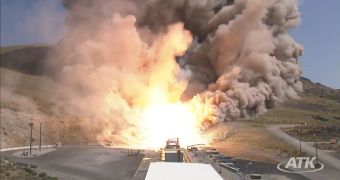Officials from the Promontory, Utah-based Alliant Techsystems (ATK) and the American space agency announce the successful completion of a firing test involving the newest rocket motor designed by engineers at ATK. According to official sources, everything went on flawlessly.
ATK engineers say that the Demonstration Motor 3 (DM3) is the largest solid rocket booster in the world. Originally, it was supposed to power up Project Constellation's ARES I delivery system, but now that project is canceled, and the rocket scrapped.
However, the company continued its work under a NASA contract, and managed to successfully complete a working version of the motor. Finally, after weeks of preparation, engineers were able to fire up DM3 yesterday, September 8.
The five-segment engine came to life shortly after 4 pm EDT (2000 GMT), and carried on for about 2 minutes, producing a deafening roar. Billowing smoke and flames charred the landscape behind the test bed, Space reports.
NASA officials believe that the new motor design will come in very handy when designing the Congress-mandated Space Launch System (SLS). This will be the next generation of heavy-lift vehicles for the Unites States, which will enable the delivery of 64 to 120 tons of material to orbit.
DM3's design is somewhat similar to that of the solid rocket boosters (SRB) that powered up NASA's space shuttles during their ascent. However, the new engines are considerably more efficient, capable of producing more thrust, and safer to operate.
According to NASA experts, the SLS will feature a core central core stage for carrying the Orion Multi-Purpose Crew Vehicle (MPCV) to low-Earth orbit (LEO). Two of the new DM3 motors will be strapped to each side of the main rocket, providing additional thrust.
ATK's technical sheets indicate that their latest creation can develop about 3.6 million pounds of thrust, which is the rough equivalent of 22 million horsepower. The motor measures 12 feet (3.7 meters) in diameter, and has a length exceeding 154 feet (47 meters).
ATK and European company Astrium are also considering the possibility of a close collaboration, for developing the Liberty space vehicle. This rocket could become a contender for carrying NASA astronauts and supplies to the International Space Station (ISS).

 14 DAY TRIAL //
14 DAY TRIAL //